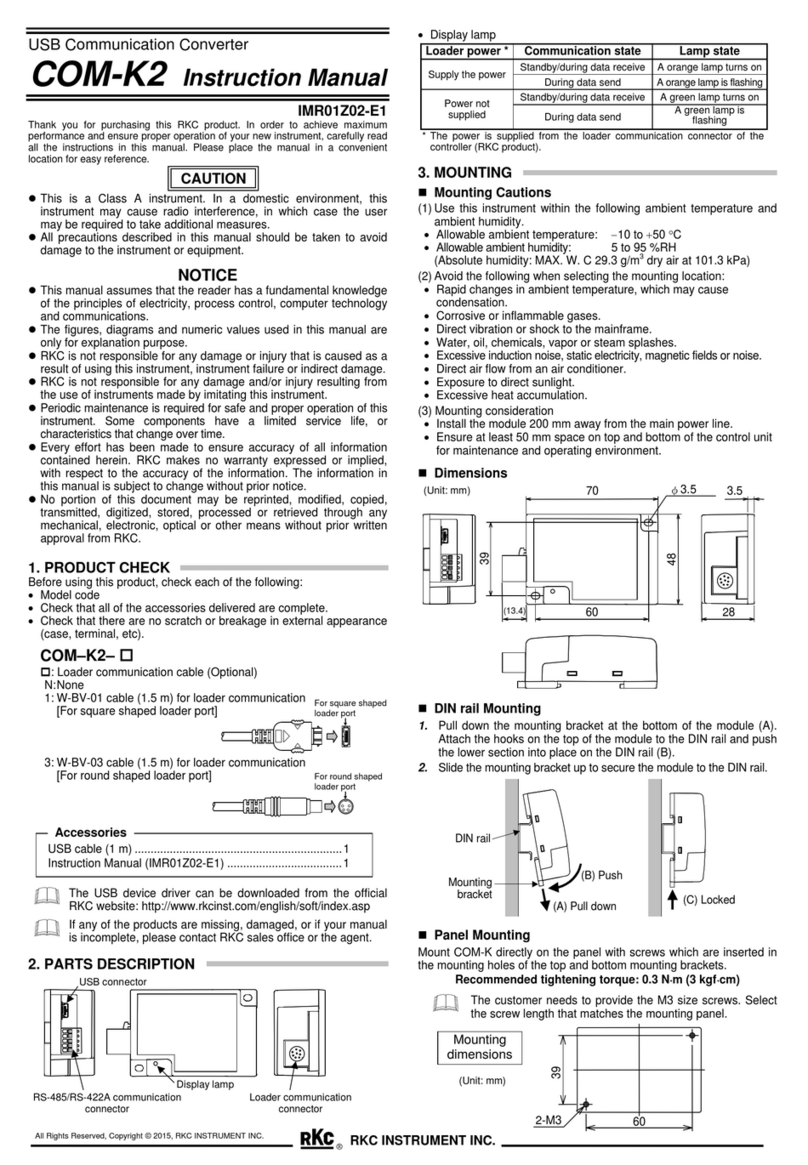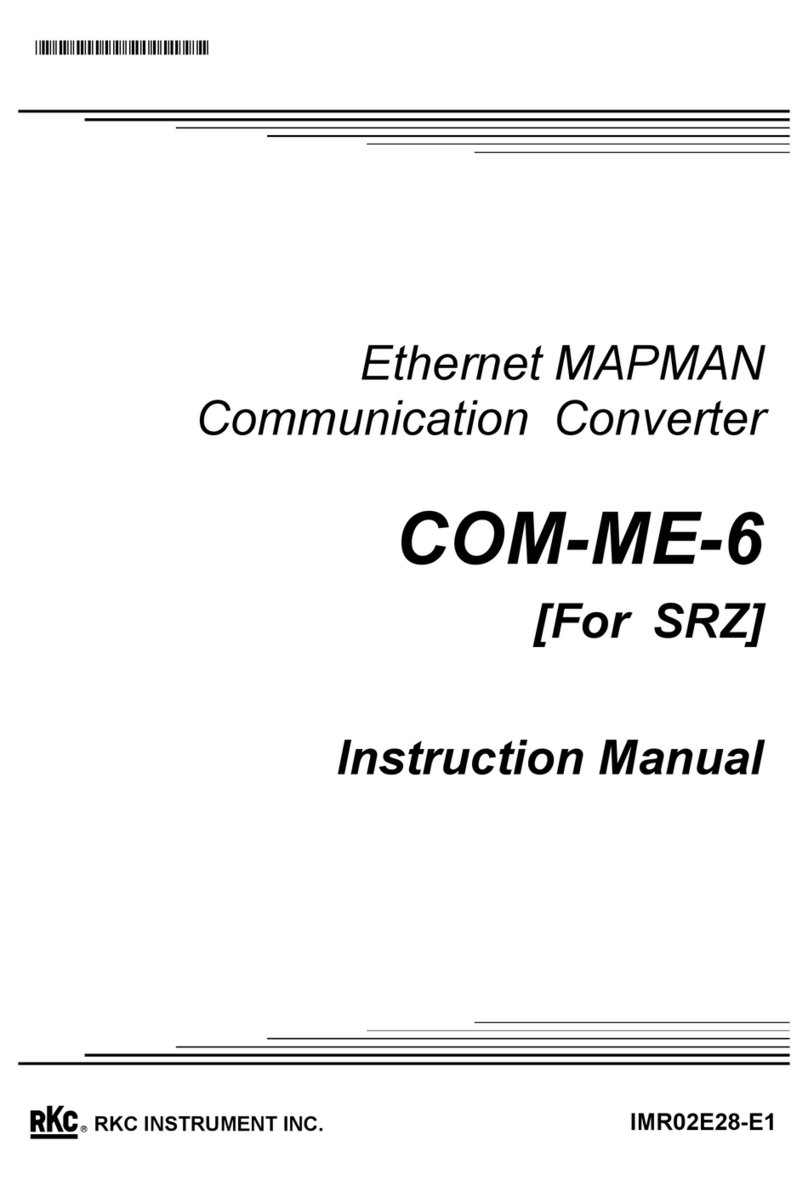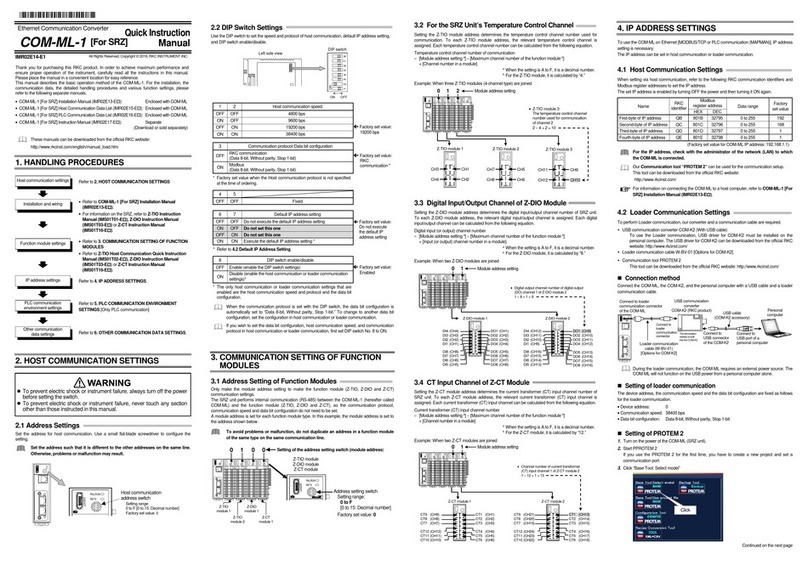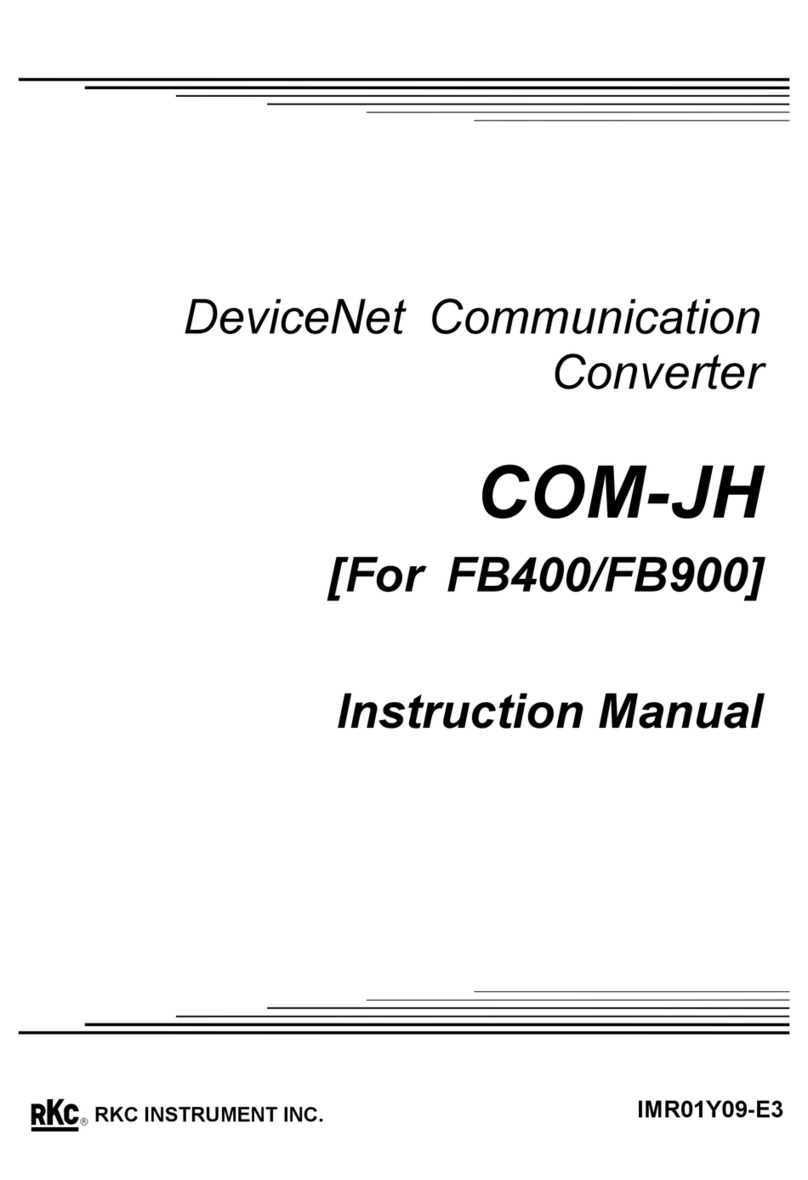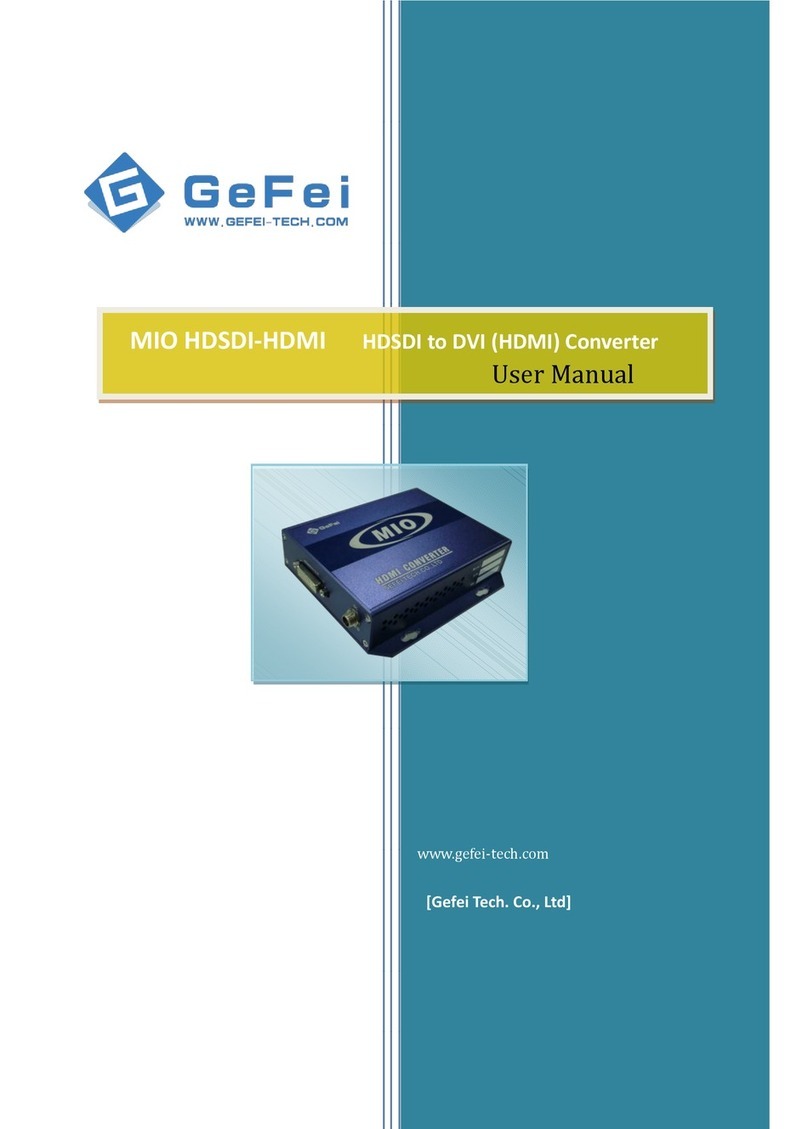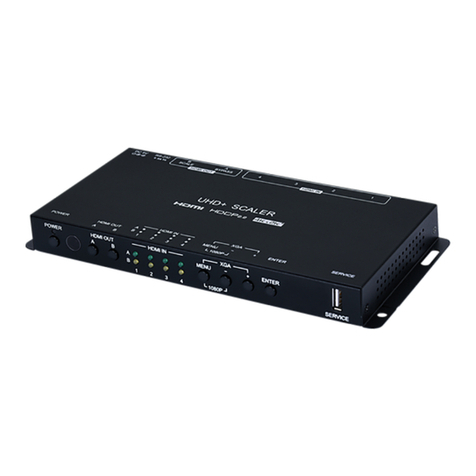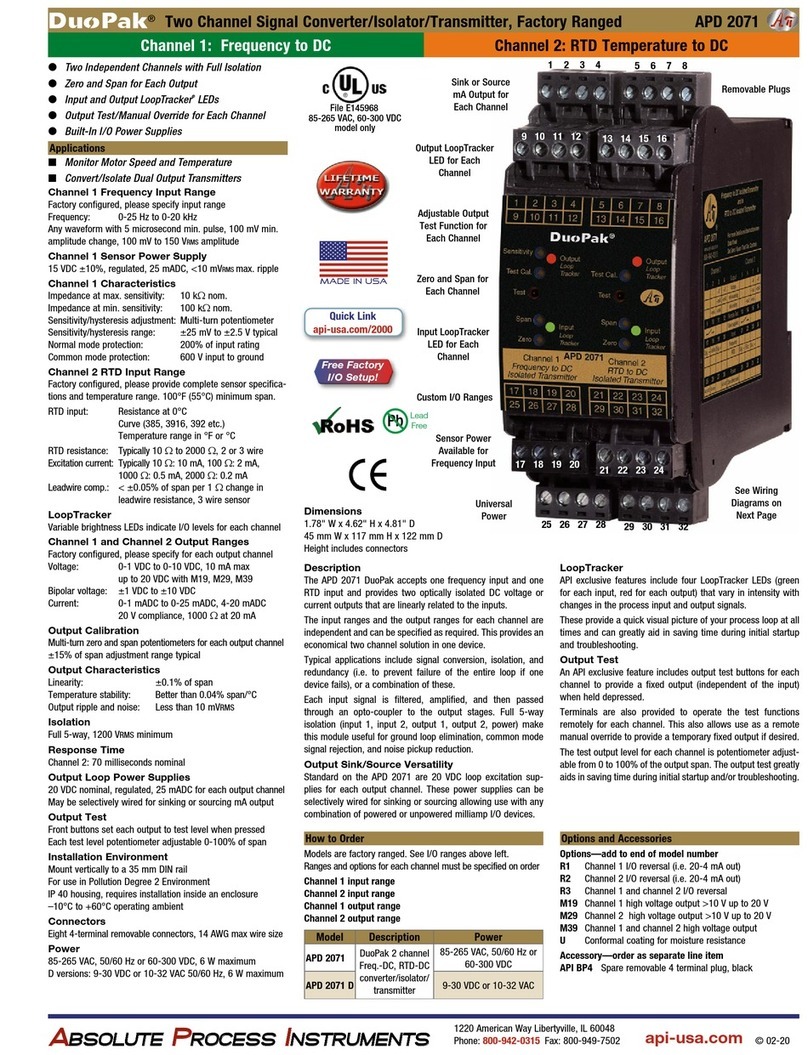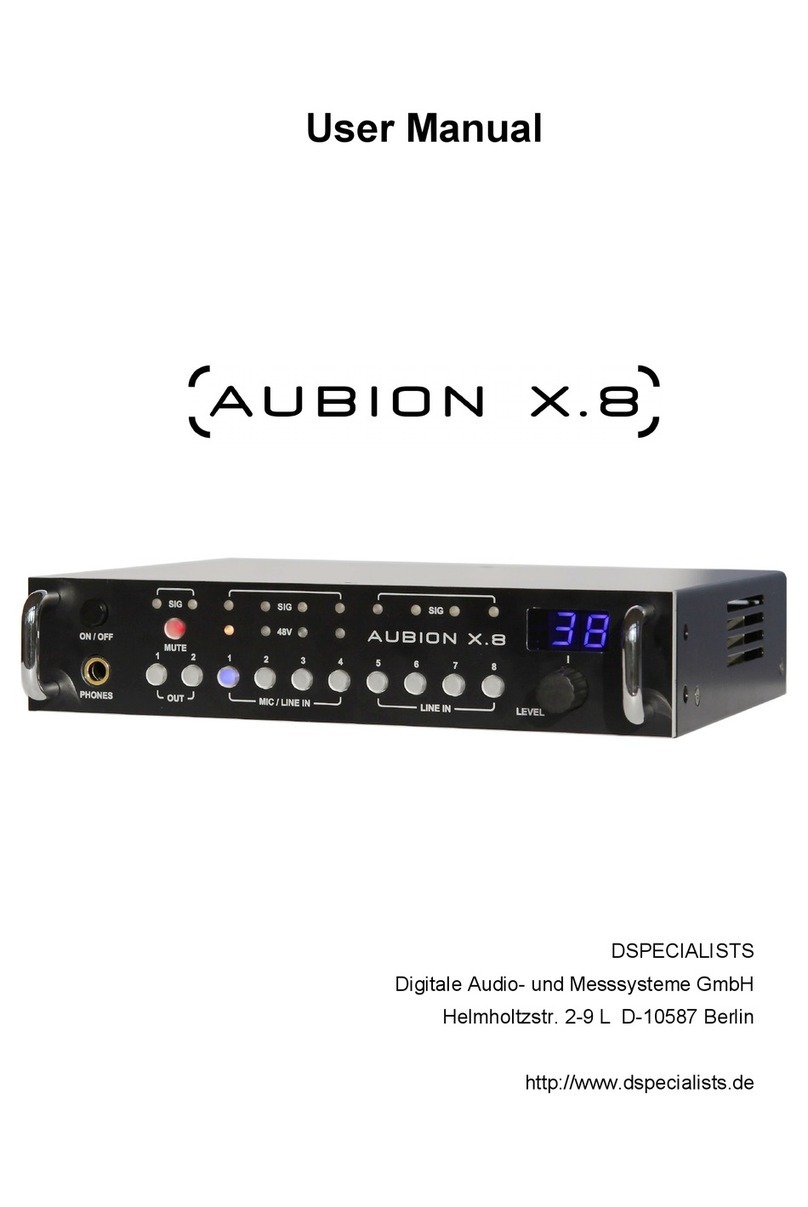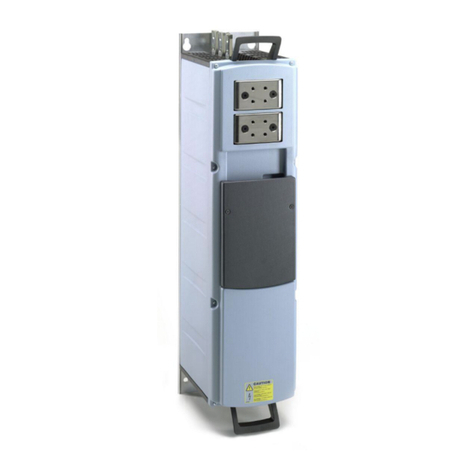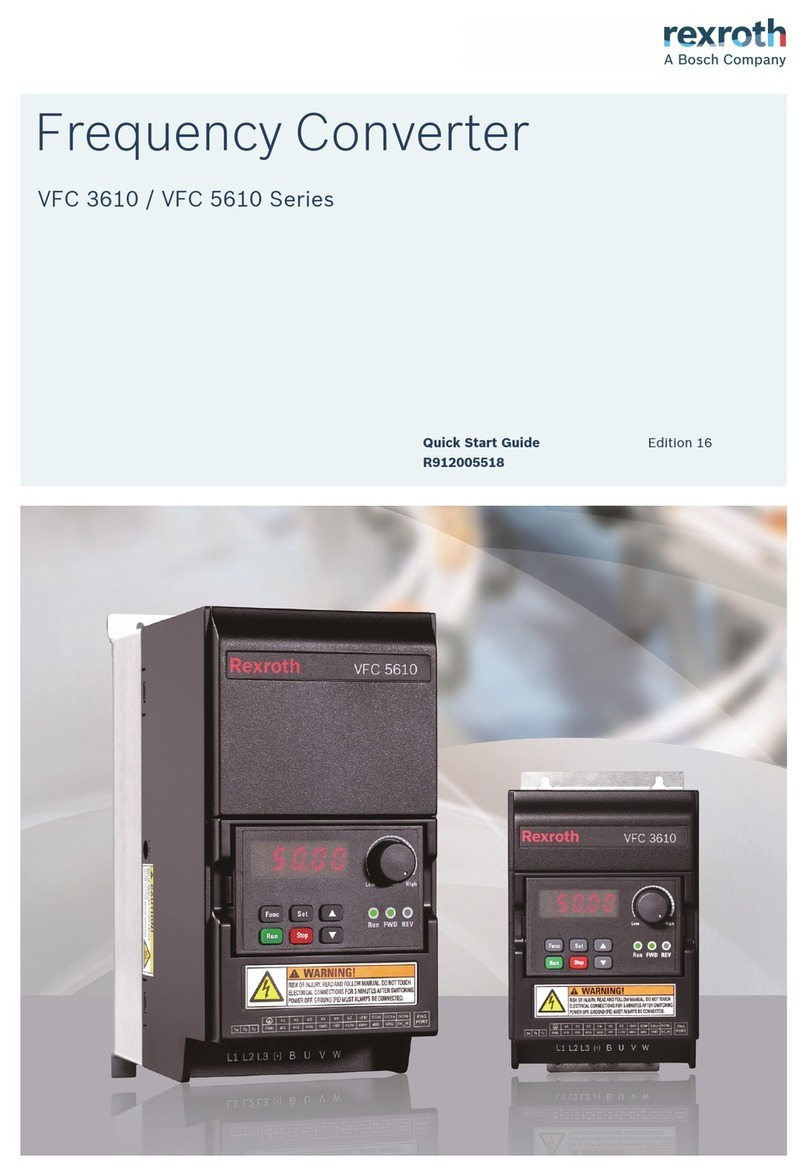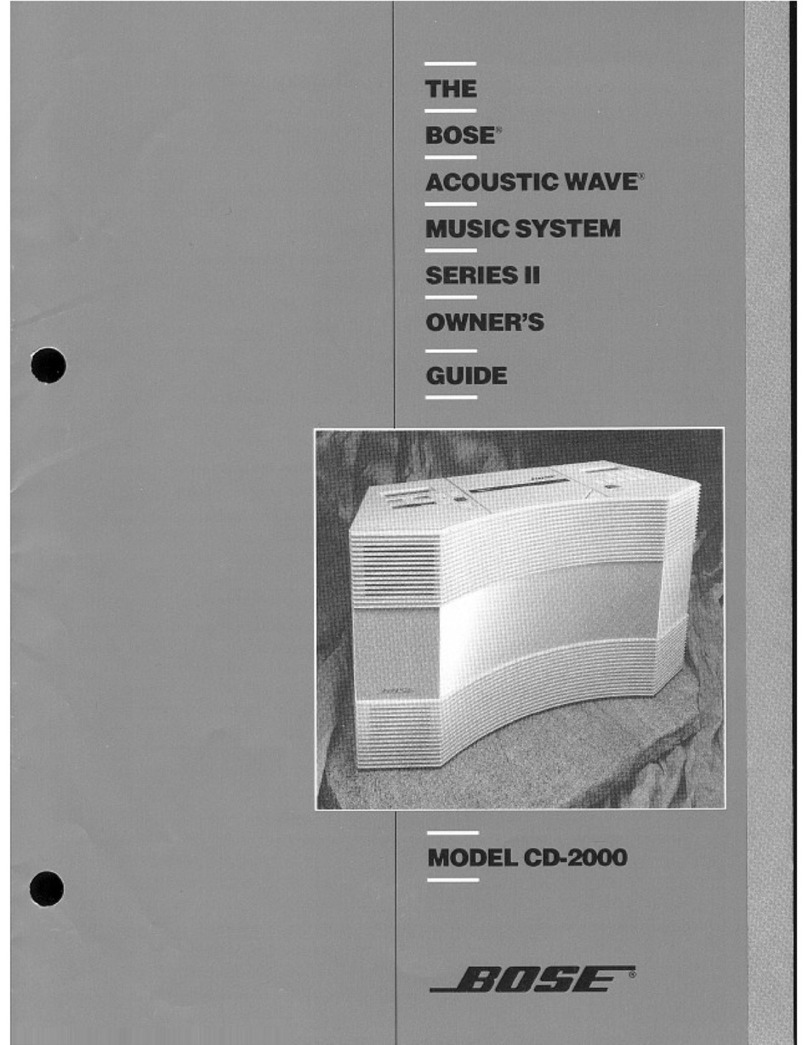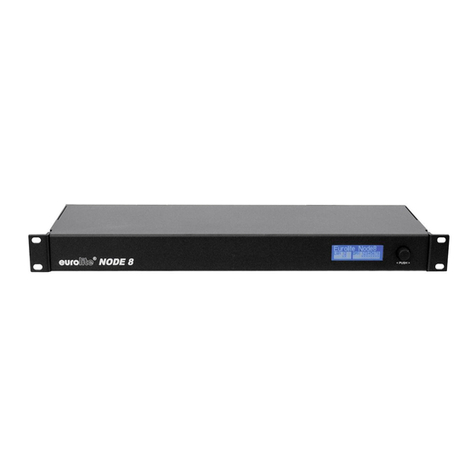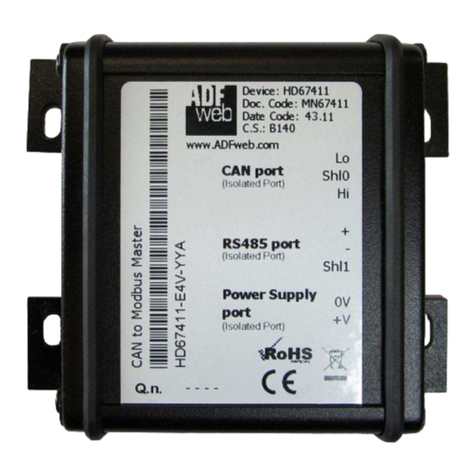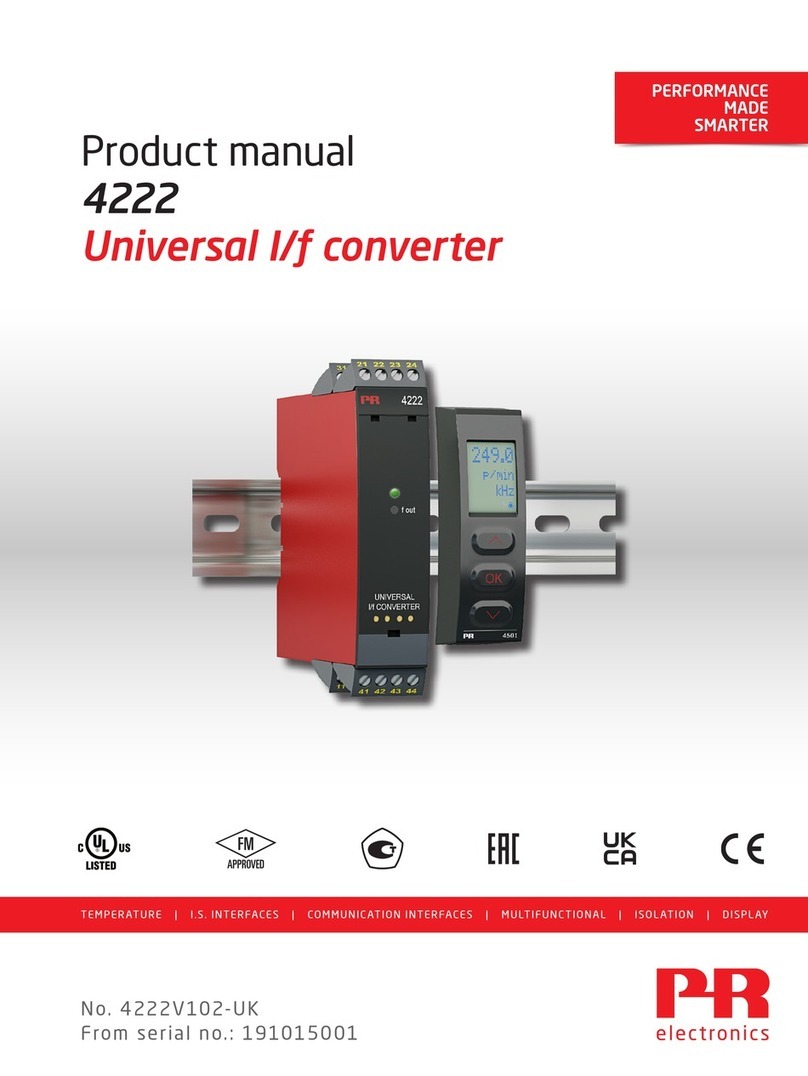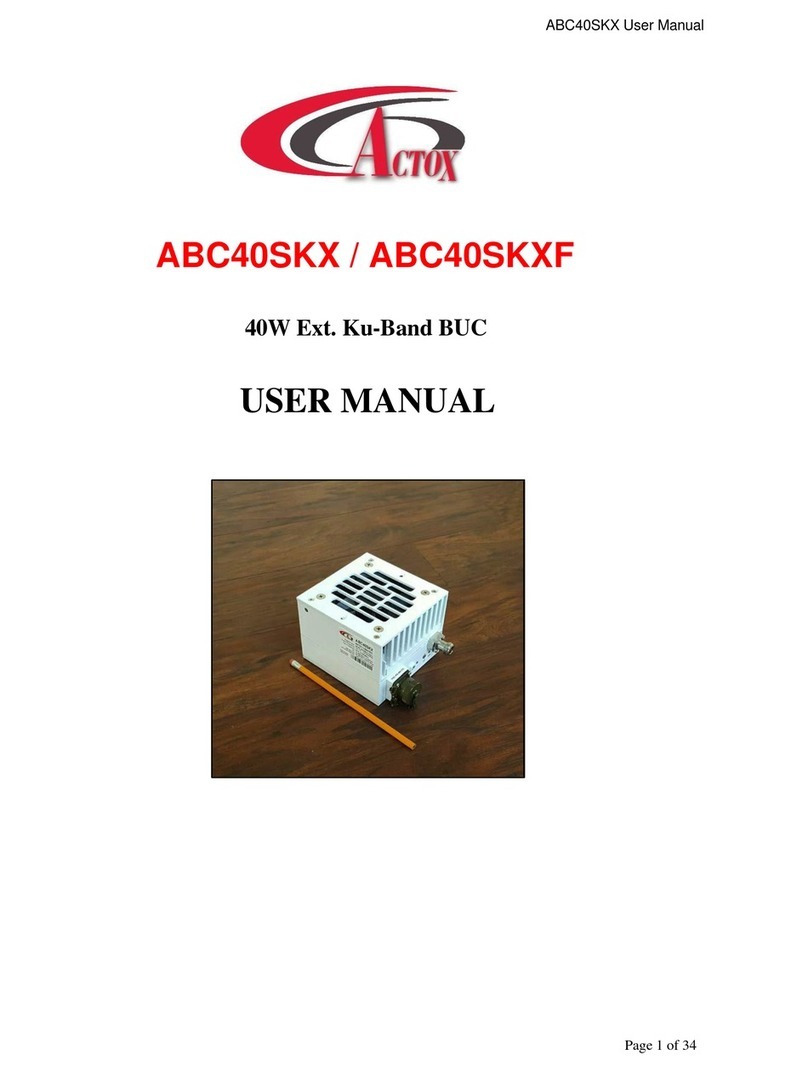RKC INSTRUMENT COM-JG User manual

IMR01Y35-E3
CO
M
-
J
G
[For SRZ]
RKC INSTRUMENT INC.
®
PROFIBUS Communication
Converte
r
Instruction Manual

All Rights Reserved, Copyright ©2006, RKC INSTRUMENT INC.
SIMATIC®is registered trademarks of SIEMENS AG.
Modbus is a registered trademark of Schneider Electric.
Company names and product names used in this manual are the trademarks or registered trademarks of
the respective companies.

IMS01Y35-E3 i-1
Thank you for purchasing this RKC product. In order to achieve maximum performance and ensure
proper operation of your new instrument, carefully read all the instructions in this manual. Please
place the manual in a convenient location for easy reference.
SYMBOLS
: This mark indicates important information on installation, handling and operating
procedures.
: This mark indicates supplemental information on installation, handling and
operating procedures.
: This mark indicates where additional information may be located.
An external protection device must be installed if failure of this instrument
could result in damage to the instrument, equipment or injury to personnel.
All wiring must be completed before power is turned on to prevent electric
shock, fire or damage to instrument and equipment.
This instrument must be used in accordance with the specifications to
prevent fire or damage to instrument and equipment.
This instrument is not intended for use in locations subject to flammable or
explosive gases.
Do not touch high-voltage connections such as power supply terminals, etc.
to avoid electric shock.
RKC is not responsible if this instrument is repaired, modified or
disassembled by other than factory-approved personnel. Malfunction can
occur and warranty is void under these conditions.
CAUTION
: This mark indicates precautions that must be taken if there is danger of electric
shock, fire, etc., which could result in loss of life or injury.
: This mark indicates that if these precautions and operating procedures are no
t
taken, damage to the instrument may result.
: This mark indicates that all precautions should be taken for safe usage.
WARNING
!
WARNING
!

IMS01Y35-E3
i-2
This product is intended for use with industrial machines, test and measuring equipment.
(It is not designed for use with medical equipment and nuclear energy.)
This is a Class A instrument. In a domestic environment, this instrument may cause radio
interference, in which case the user may be required to take additional measures.
This instrument is protected from electric shock by reinforced insulation. Provide reinforced
insulation between the wire for the input signal and the wires for instrument power supply,
source of power and loads.
Be sure to provide an appropriate surge control circuit respectively for the following:
- If input/output or signal lines within the building are longer than 30 meters.
- If input/output or signal lines leave the building, regardless the length.
This instrument is designed for installation in an enclosed instrumentation panel. All
high-voltage connections such as power supply terminals must be enclosed in the
instrumentation panel to avoid electric shock by operating personnel.
All precautions described in this manual should be taken to avoid damage to the instrument or
equipment.
All wiring must be in accordance with local codes and regulations.
All wiring must be completed before power is turned on to prevent electric shock, instrument
failure, or incorrect action.
The power must be turned off before repairing work for input break and output failure including
replacement of sensor, contactor or SSR, and all wiring must be completed before power is
turned on again.
To prevent instrument damage or failure, protect the power line and the input/output lines from
high currents with a protection device such as fuse, circuit breaker, etc.
Prevent metal fragments or lead wire scraps from falling inside instrument case to avoid
electric shock, fire or malfunction.
Tighten each terminal screw to the specified torque found in the manual to avoid electric shock,
fire or malfunction.
For proper operation of this instrument, provide adequate ventilation for heat dispensation.
Do not connect wires to unused terminals as this will interfere with proper operation of the
instrument.
Turn off the power supply before cleaning the instrument.
Do not use a volatile solvent such as paint thinner to clean the instrument. Deformation or
discoloration will occur. Use a soft, dry cloth to remove stains from the instrument.
To avoid damage to instrument display, do not rub with an abrasive material or push front
panel with a hard object.
Do not connect modular connectors to telephone line.
When high alarm with hold action/re-hold action is used for Event function, alarm does not turn
on while hold action is in operation. Take measures to prevent overheating which may occur if
the control device fails.
NOTICE
This manual assumes that the reader has a fundamental knowledge of the principles of electricity,
process control, computer technology and communications.
The figures, diagrams and numeric values used in this manual are only for purpose of illustration.
RKC is not responsible for any damage or injury that is caused as a result of using this instrument,
instrument failure or indirect damage.
RKC is not responsible for any damage and/or injury resulting from the use of instruments made by
imitating this instrument.
Periodic maintenance is required for safe and proper operation of this instrument. Some components
have a limited service life, or characteristics that change over time.
Every effort has been made to ensure accuracy of all information contained herein. RKC makes no
warranty expressed or implied, with respect to the accuracy of the information. The information in this
manual is subject to change without prior notice.
No portion of this document may be reprinted, modified, copied, transmitted, digitized, stored,
processed or retrieved through any mechanical, electronic, optical or other means without prior
written approval from RKC.
CAUTION

IMS01Y35-E3 i-3
CONTENTS
Page
1. OUTLINE ............................................................................ 1
1.1 Product Check ................................................................................................2
1.2 Model Code ....................................................................................................2
1.3 Parts Description ............................................................................................3
2. HANDLING PROCEDURES............................................... 4
3. MOUNTING......................................................................... 5
3.1 Mounting Cautions..........................................................................................5
3.2 Dimensions.....................................................................................................6
3.3 DIN Rail Mounting ..........................................................................................6
3.4 Panel Mounting...............................................................................................7
4. WIRING............................................................................... 8
4.1 Wiring Cautions ..............................................................................................8
4.2 Terminal Configuration ...................................................................................9
4.3 Connection to PROFIBUS ............................................................................10
4.4 Connection to the Controllers .......................................................................12
4.5 Installation of Termination Resistor...............................................................13
5. SETTING........................................................................... 15
5.1 PROFIBUS Address Setting .........................................................................15
5.2 DIP Switch Setting ........................................................................................16
5.3 COM-JG Initial Setting ..................................................................................17
5.4 Controller Address Auto Obtain Methods .....................................................19
6. PROFIBUS COMMUNICATION ....................................... 21
6.1 PROFIBUS System Configuration ................................................................21
6.2 PROFIBUS Communication Data .................................................................22
6.2.1 Data types and data length of communication data .......................................... 22
6.2.2 Static data request.............................................................................................22
6.2.3 Dynamic data request ....................................................................................... 23
6.2.4 Registers assigned to PLC................................................................................ 25
6.3 Processing of Numeric Data Values .............................................................27

IMS01Y35-E3
i-4
Page
7. COMMUNICATION DATA MAP....................................... 28
7.1 Reference to Communication Data Map.......................................................28
7.2 Communication Data of Z-TIO Module .........................................................30
7.3 Memory Area Data of Z-TIO Module.............................................................51
7.4 Communication Data of Z-DIO Module.........................................................53
7.5 COM-JG Initial Setting Items ........................................................................58
8. USAGE EXAMPLE ........................................................... 60
8.1 Handling Procedures ....................................................................................60
8.2 System Configuration ...................................................................................61
8.3 Use Instruments Setting................................................................................62
8.4 Contents Check of COM-JG Initial Setting....................................................63
8.5 PLC Tool Setting...........................................................................................70
8.5.1 Setting procedures ............................................................................................ 70
8.5.2 General procedures........................................................................................... 73
8.5.3 COM-JG initial setting ....................................................................................... 83
8.5.4 Communication item setting ............................................................................ 102
9. TROUBLESHOOTING.................................................... 113
10. SPECIFICATIONS.......................................................... 116

IMR01Y35-E3 1
1. OUTLINE
This manual describes the communication specifications, mounting, wiring, setting and data
instructions for the PROFIBUS Communication Converter COM-JG [For SRZ].
PROFIBUS Communication Converter COM-JG [For SRZ] (hereafter called COM-JG) is
communication converter to connect the RKC module type controller SRZ to a programmable
controller (hereafter called PLC) for PROFIBUS.
The COM-JG supports PROFIBUS-DP protocol. This protocol includes master and slave. The PLC is
the master and the COM-JG is the slave.
Power supply (24 V DC)
PROFIBUS-DP
PROFIBUS
communication
converter
COM-JG
(Slave)
Programmable controller
PLC (Master)
Controller communication
(RS-485: Modbus)
SRZ unit
(Z-TIO and Z-DIO module)
[Up to 31 modules]
1 2 3 31
For PROFIBUS, refer to the website of PROFIBUS International.
URL: http://www.profibus.com/

1. OUTLINE
IMR01Y35-E3
2
1.1 Product Check
Before using this product, check each of the following.
Model code
Check that there are no scratches or breakage in external appearance (case, front panel, terminal, etc).
Check that all of the accessories delivered are complete. (Refer to below)
Accessories Q’TY Remarks
COM-JG [For SRZ] Installation Manual
(IMR01Y23-E)
1 Enclosed with instrument
COM-JG [For SRZ] Quick Instruction Manual
(IMR01Y27-E)
1 Enclosed with instrument
COM-JG [For SRZ] Communication Data List
(IMR01Y31-E)
1 Enclosed with instrument
COM-JG [For SRZ] Instruction Manual
(IMR01Y35-E3)
1 This manual
(Download free or purchase hard copy)
GSD file * 1 Download free
If any of the products are missing, damaged, or if your manual is incomplete, please contact
RKC sales office or the agent.
* GSD file
The GSD file for COM-JG can be downloaded from the RKC official website.
(URL: http://www.rkcinst.com/english/download/field_network.htm)
1.2 Model Code
Check that the product received is correctly specified by referring to the following model code list:
If the product is not identical to the specifications, please contact RKC sales office or the agent.
COM- JG ∗02
Corresponding to the RKC controller
02: SRZ

1. OUTLINE
IMR01Y35-E3 3
1.3 Parts Description
Address setting
switch
Indication
lamps
Terminal cover
Front view Left side view
Terminal base
Mainframe
DIP switch
Terminal cove
r
Mounting
bracke
t
PROFIBUS
connector
(COM.PORT) FAIL
RUN
ONL
RX/T
X
[Details of Indication lamps]
Indication lamps
FAIL [Red] •When instrument abnormally: Turns on
RUN [Green] •When normally: Turns on
•Operation error: Flashes slowly
•During controller communication initialization: Flashes rapidly
ONL [Green] During PROFIBUS connection establishment: Turns on
RX/TX [Green] During PROFIBUS data send and receive: Flashes
PROFIBUS connector
COM. PORT Connector for PLC (Master) connection
Switches
Address setting switch Set the address for PROFIBUS
DIP switch Set the communication speed for controller communication,
controller address auto obtain, and controller communication
enable/disable
Others
Terminal cover Terminal covers above and below the COM-JG
Mounting bracket •Used for the DIN rail mounting
•When panel mounted, two mounting brackets are required for the
upper and lower sides (one required for the upper side: separately
sold).
Terminal base Part of the terminal and base of COM-JG
(There is the Termination resistor transfer switch in the inside of
terminal base)
Mainframe Part of the mainframe of COM-JG

4 IMR01Y35-E3
2. HANDLING PROCEDURES
Conduct the setting necessary for performing communication in accordance with the following procedure.
To avoid error at operation start-up, COM-JG must be powered on LAST (after the
controller, PLC, etc.).
Mounting Install the COM-JG.
•Refer to 3. MOUNTING (P. 5)
•For controller (SRZ), refer to Z-TIO INSTRUCTION
MANUAL (IMS01T01-E) or Z-DIO
INSTRUCTION MANUAL (IMS01T03-E)
COM-JG Setting
Wiring
and
Connection
Controller (SRZ) Setting
Communication Data
Setting
Set the PROFIBUS address and DIP switch setting of COM-JG.
Refer to 5. SETTING (P. 15)
Connect power supply wires to the COM-JG, and also connect
the COM-JG to the controller (SRZ) and the COM-JG to the
PLC, respectively.
•Refer to 4. WIRING (P. 8)
•For controller (SRZ), refer to Z-TIO INSTRUCTION
MANUAL (IMS01T01-E) or Z-DIO
INSTRUCTION MANUAL (IMS01T03-E)
Set communication parameters of controller (SRZ).
•Refer to 8.3 Use Instruments Setting (P. 62)
•Refer to Z-TIO Host Communication Quick Manual
(IMS01T02-E)or Z-DIO INSTRUCTION
MANUAL (IMS01T03-E)
Set PLC programming software STEP7.
Refer to 8.5 PLC Tool Setting (P. 70)
COM-JG Initial Setting Set initial setting of the COM-JG.
•Refer to 5.3 COM-JG Initial Setting (P. 17)
•Refer to 5.4 Controller Address Auto Obtain
Methods (P. 19)
•Refer to 8.4 Contents Check of COM-JG Initial
Setting (P. 63)
•Refer to 8.5 PLC Tool Setting (P. 70)

IMR01Y35-E3 5
3. MOUNTING
This chapter describes installation environment, mounting cautions, dimensions and mounting
procedures.
3.1 Mounting Cautions
(1) This instrument is intended to be used under the following environmental conditions. (IEC61010-1)
[OVERVOLTAGE CATEGORY II, POLLUTION DEGREE 2]
(2) Use this instrument within the following environment conditions:
• Allowable ambient temperature: −10 to +50 °C (14 to 122 °F)
• Allowable ambient humidity: 5 to 95 % RH
(Absolute humidity: MAX.W.C 29.3 g/m3dry air at 101.3 kPa)
• Installation environment conditions: Indoor use
Altitude up to 2000 m
(3) Avoid the following conditions when selecting the mounting location:
• Rapid changes in ambient temperature which may cause condensation.
• Corrosive or inflammable gases.
• Direct vibration or shock to the mainframe.
• Water, oil, chemicals, vapor or steam splashes.
• Excessive dust, salt or iron particles.
• Excessive induction noise, static electricity, magnetic fields or noise.
• Direct air flow from an air conditioner.
• Exposure to direct sunlight.
• Excessive heat accumulation.
(4) Mount this instrument in the panel considering the following conditions:
• Ensure at least 50 mm space on top and bottom of the instrument for maintenance and
environmental reasons.
• Do not mount this instrument directly above equipment that generates large amount of heat
(heaters, transformers, semi-conductor functional devices, large-wattage resistors).
• If the ambient temperature rises above 50 °C (122 °F), cool this instrument with a forced air fan,
cooler, etc. Cooled air should not blow directly on this instrument.
• In order to improve safety and the immunity to withstand noise, mount this instrument as far
away as possible from high voltage equipment, power lines, and rotating machinery.
High voltage equipment: Do not mount within the same panel.
Power lines: Separate at least 200 mm.
Rotating machinery: Separate as far as possible.
(5) If this instrument is permanently connected to equipment, it is important to include a switch or
circuit-breaker into the installation. This should be in close proximity to the equipment and within
easy reach of the operator. It should be marked as the disconnecting device for the equipment.
To prevent electric shock or instrument failure, always turn off the power before
mounting or removing the instrument.
WARNING
!

3. MOUNTING
IMR01Y35-E3
6
3.2 Dimensions
109.5 330
125
78
5
6.5
3.3 DIN Rail Mounting
Mounting procedures
1. Pull down the mounting bracket at the bottom of the instrument (A). Attach the hooks on the top
of the instrument to the DIN rail and push the lower section into place on the DIN rail (B).
2. Slide the mounting bracket up to secure the instrument to the DIN rail (C).
(B) Push
Mounting
bracke
t
DIN rail
(A) Pull down (C) Locked
(Unit: mm)

3. MOUNTING
IMR01Y35-E3 7
Removal procedures
1. Turn the power OFF.
2. Remove the wiring.
3. Pull down a mounting bracket with
a slotted screwdriver (A). Lift the
instrument from bottom, and take it
off (B).
3.4 Panel Mounting
Mounting procedures
1. Pull down the mounting bracket (A) until locked and that a mounting hole appears.
2. Prepare one mounting bracket per instrument (B) sold separately (KSRX-55) and then insert it in
the rear of the terminal board at top of the instrument until locked but a mounting hole does not
disappear.
3. Mount each module directly on the panel with screws which are inserted in the mounting holes of
the top and bottom mounting brackets.
Recommended tightening torque: 0.3 N⋅m (3 kgf⋅cm)
The customer needs to provide the M3 size screws. Select the screw length that matches the
mounting panel.
(A) Pull down
(B) Insert
Mounting bracket
(Sold separately)
(KSRX-55)
Mounting
holes
Mounting dimensions
130.5 ±0.2
M3
(Unit: mm)
(A) Pull down
(B) Lift and take
off

8IMR01Y35-E3
4. WIRING
This chapter describes wiring cautions, terminal configuration and connections.
4.1 Wiring Cautions
• To avoid noise induction, keep communication signal wire away from instrument power line, load
lines and power lines of other electric equipment.
• If there is electrical noise in the vicinity of the instrument that could affect operation, use a noise
filter.
− Shorten the distance between the twisted power supply wire pitches to achieve the most effective
noise reduction.
− Always install the noise filter on a grounded panel. Minimize the wiring distance between the
noise filter output and the instrument power supply terminals to achieve the most effective noise
reduction.
− Do not connect fuses or switches to the noise filter output wiring as this will reduce the
effectiveness of the noise filter.
• Power supply wiring must be twisted and have a low voltage drop.
• For an instrument with 24 V power supply, supply power from a SELV circuit.
• A suitable power supply should be considered in end-use equipment. The power supply must be in
compliance with a limited-energy circuits (maximum available current of 8 A).
• Use the solderless terminal appropriate to the screw size (M3).
• Make sure that the any wiring such as solderless terminal is not in contact with the adjoining terminals.
To prevent electric shock or instrument failure, do not turn on the power until all
wiring is completed. Make sure that the wiring is correct before applying power
to the instrument.
WARNING
!
5.9 mm or less
3.2 mm or more
Recommended tightening torque:
0.4 N⋅m (4 kgf⋅cm)

4. WIRING
IMR01Y35-E3 9
4.2 Terminal Configuration
The terminal layout is as follows.
+−
24 V
DC
12
9 8
FG
Controller
communication
T/R(B)
T/R(A)
RS-485
1
5
SG
4
Upper-side
terminal
Lower-side
terminal
Power supply Ground
2 1
7 6 5 4
14 13 12
11 10 9 8
3
: The part of internal wiring
As controller communication terminal Nos. 1, 4 and 5 are internally connected to terminal Nos. 3,
6 and 7, any terminals can be used.
As ground and power supply terminal Nos. 8, 9 and 12 are internally connected to terminal Nos.
10, 11 and 14, any terminals can be used.
Terminal No. 2 and No. 13 is not used.

4. WIRING
IMR01Y35-E3
10
4.3 Connection to PROFIBUS
Connect COM-JG to PROFIBUS.
Pin layout of connector
PROFIBUS connector
(COM. PORT)
1
5
6
9
COM-JG
Pin No. Signal name Symbol
1 ⎯Unused
2 ⎯Unused
3 Receive data /Transmission data (plus) RxD/TxD-P
4 ⎯Unused
5 Signal ground DGND
6 Termination resistor supply voltage (5 V) VP
7 ⎯Unused
8 Receive data /Transmission data (negative) RxD/TxD-N
9 ⎯Unused
For the connectable connector of the PLC, refer to the instruction manual for the used PLC.

4. WIRING
IMR01Y35-E3 11
PROFIBUS cables
Use the PROFIBUS cable which fitted the following requirement.
• Use the shielded twisted pair wire
• Based on IEC61158, Standard (Recommend cable type A)
Cable type A specification
Impedance: 135 to 165 Ω
Capacitance: < 30 pF/m
Loop resistance: 110 Ω/km
Core diameter: 0.64 mm
Core cross section: > 0.34 mm2
Maximum cable length by communication speed (For cable type A)
Communication speed (kbps) 9.6 19.2 93.75 187.5 500 1500 12000
Cable length (m) 1200 1200 1200 1000 400 200 100
• Connect the termination resistor to the end of a bus (Refer to below)
Termination resistor
Signal
VP
390
Ω
220
Ω
390
Ω
RxD/TxD-P
RxD/TxD-N
DGND
Customer must provide the PROFIBUS cable (a connection cable of PLC and COM-JG).
As for the PROFIBUS cable, there is a case prepared by a PLC manufacturer.
The details except the above are connected to a website of PROFIBUS International, and
obtain necessary information.
URL: http://www.profibus.com/

4. WIRING
IMR01Y35-E3
12
4.4 Connection to the Controllers
Conduct wiring between the COM-JG and controller (SRZ) as shown in the following.
SRZ (Z-TIO module/Z-DIO module) communication terminal number and
signal details
Terminal No. Signal name Symbol
3 Send/Receive data T/R (A)
4 Send/Receive data T/R (B)
5 Signal ground SG
Wiring
RS-485
Paired
wire
Shielded twisted
pair wire
Controller (SRZ)
Up to 16 Z-TIO modules can be connected.
R2
R2: Termination resistor for external
connection (120
Ω1/2 W)
3
4
5SG
COM-JG
SG
1
5
4
R1
Terminal block
T/R (A)
T/R (B)
3
4
5SG
T/R (B)
T/R (A)
T/R (B)
T/R (A)
Z-TIO module
Z-TIO module
Connected by
the internal
communication
line
R1: Internal termination resistor
(Example: 120 Ω1/2 W)
(+)
(−)
(+)
(−)
(+)
(−)
The cable and termination resistor(s) must be provided by the customer.
A combined total of up to 31 Z-TIO and Z-DIO modules can be connected in the SRZ,
however, in some cases this may not be possible due to restrictions related to the number of
connected channels and communication items.
[ Refer to 6.2.1 Data type and data length of communication data (P. 22)]
3 4 5
21
SRZ base section
Communication
terminal No.
For termination resistors, refer to
4.5 Installation of Termination
Resistor (P. 13)

4. WIRING
IMR01Y35-E3 13
4.5 Installation of Termination Resistor
Procedure for setting a termination resistor to Controller communication (RS-485) and its setting
position are described in the following.
If communication errors occur frequently due to the operation environment or the
communication distance, connect termination resistors.
Termination resistor setting position
If the COM-JG is connected to the extreme end of the communication line, install one termination
resistor each to the COM-JG and the controller (module of the SRZ) located most distantly from the
COM-JG.
Setting procedure of termination resistor (COM-JG)
As the COM-JG is internally provided with a selector switch for choosing the ON/OFF of a
termination resistor, it is not required to externally install the termination resistor.
(Factory set value: Termination resistor connected)
1. Turn off the power supply of the COM-JG.
Do not separate the mainframe from terminal base with the power turned on. If so,
instrument failure may result.
2. Pull out the mainframe itself toward you while pushing the locks at its top and bottom (1), and
then separate it from the terminal base (2).
Upper-side
lock
Lower-side
lock
Top view
Bottom view
(2) Pull out
(1) Push
(1) Push
Terminal base
Mainframe
Removing the module mainframe
Controller communication
(RS-485: Modbus)
COM-JG
Termination
resistor ON
(Factory
set value)
SRZ unit
Z-TIO or Z-DIO module
Connect a termination
resistor to the terminals
from exterior.
Internal communication line
(RS-485)
Termination resisto
r

4. WIRING
IMR01Y35-E3
14
3. Turn on the Termination resistor transfer switch in the terminal base.
The COM-JG is shipped from the factory with the selector switch set to “ON: Termination
resistor connected.”
Termination resistor
transfer switch
Termination
resistor ON
(120 Ω1/2 W)
Termination
resistor OFF
Factory set value: ON
OFF
ON
A terminal base of the state which removed module mainframe
4. Push the mainframe thus separated in the terminal base until firmly locked.
Terminal base
Mainframe
Push the module
mainframe until
firmly locked
Mounting the module mainframe
Table of contents
Other RKC INSTRUMENT Media Converter manuals
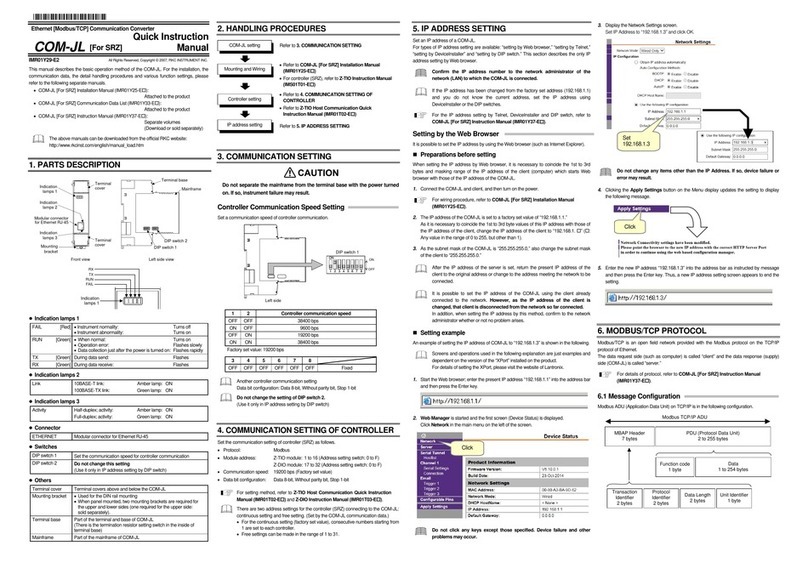
RKC INSTRUMENT
RKC INSTRUMENT COM-JL User manual

RKC INSTRUMENT
RKC INSTRUMENT COM-ML-1 User manual
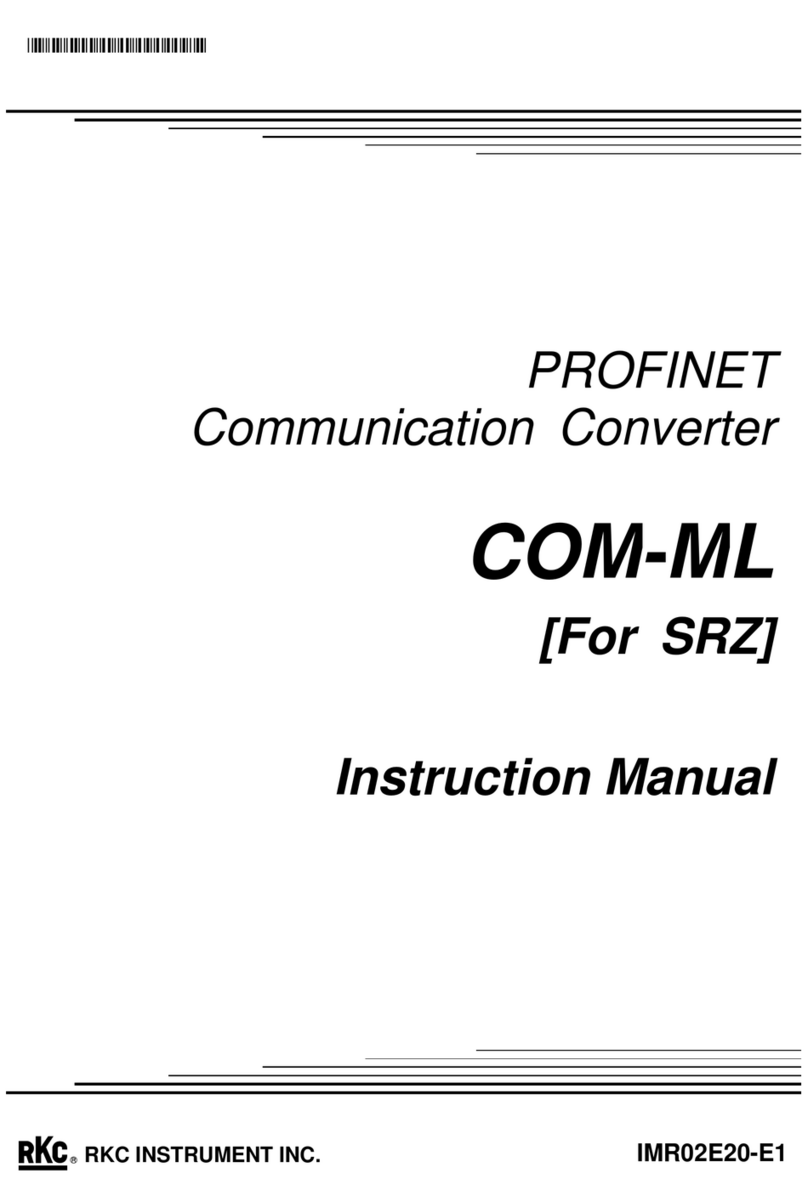
RKC INSTRUMENT
RKC INSTRUMENT COM-ML User manual
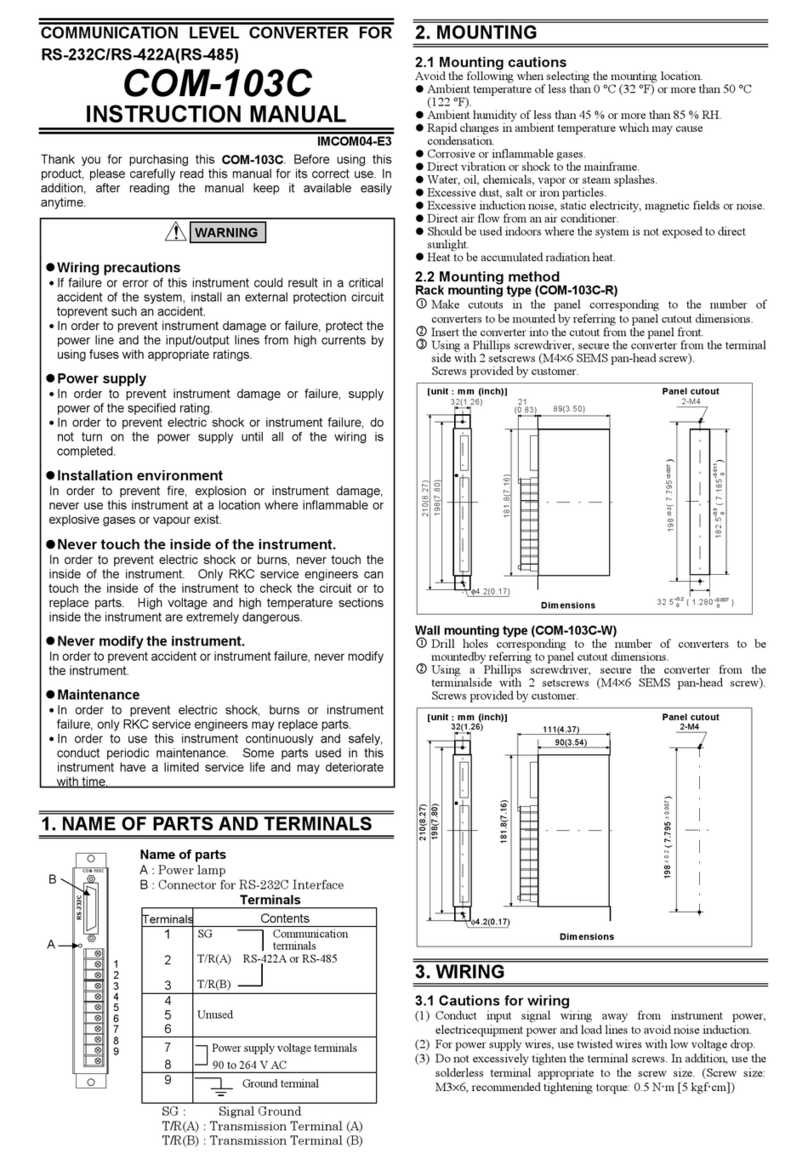
RKC INSTRUMENT
RKC INSTRUMENT COM-103C User manual
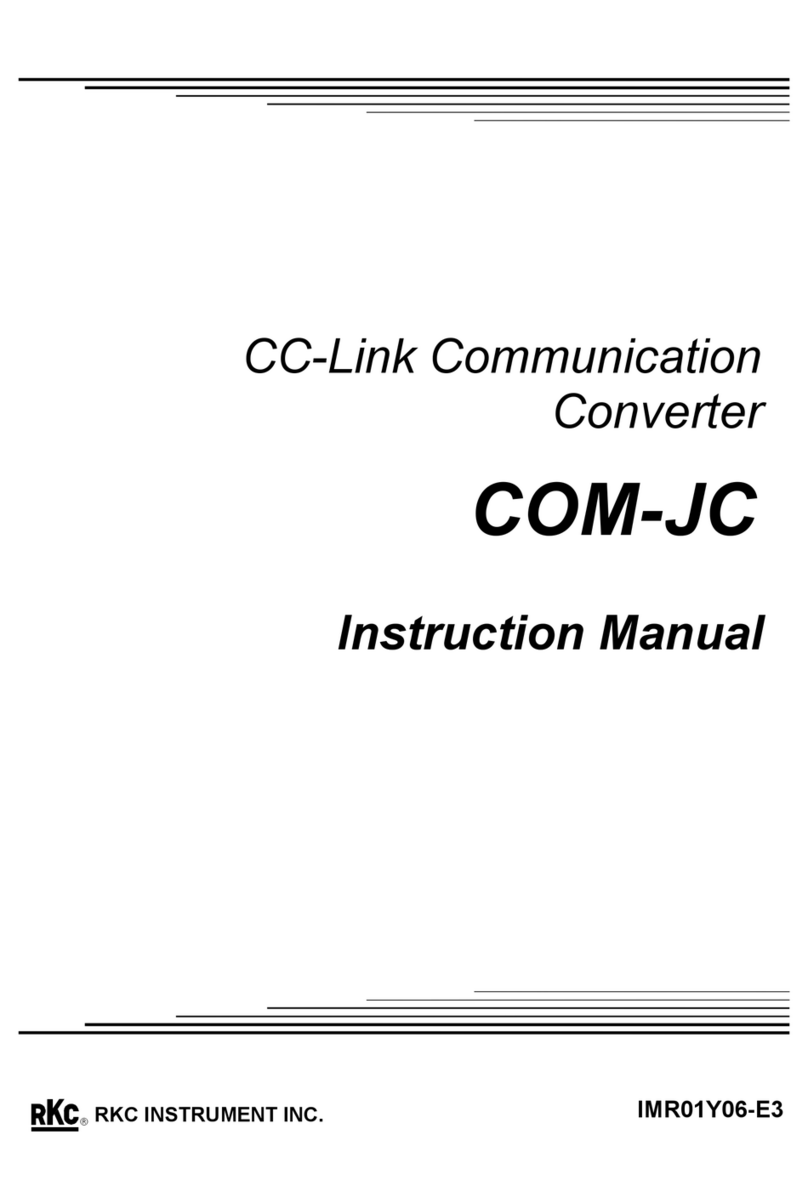
RKC INSTRUMENT
RKC INSTRUMENT COM-JC User manual
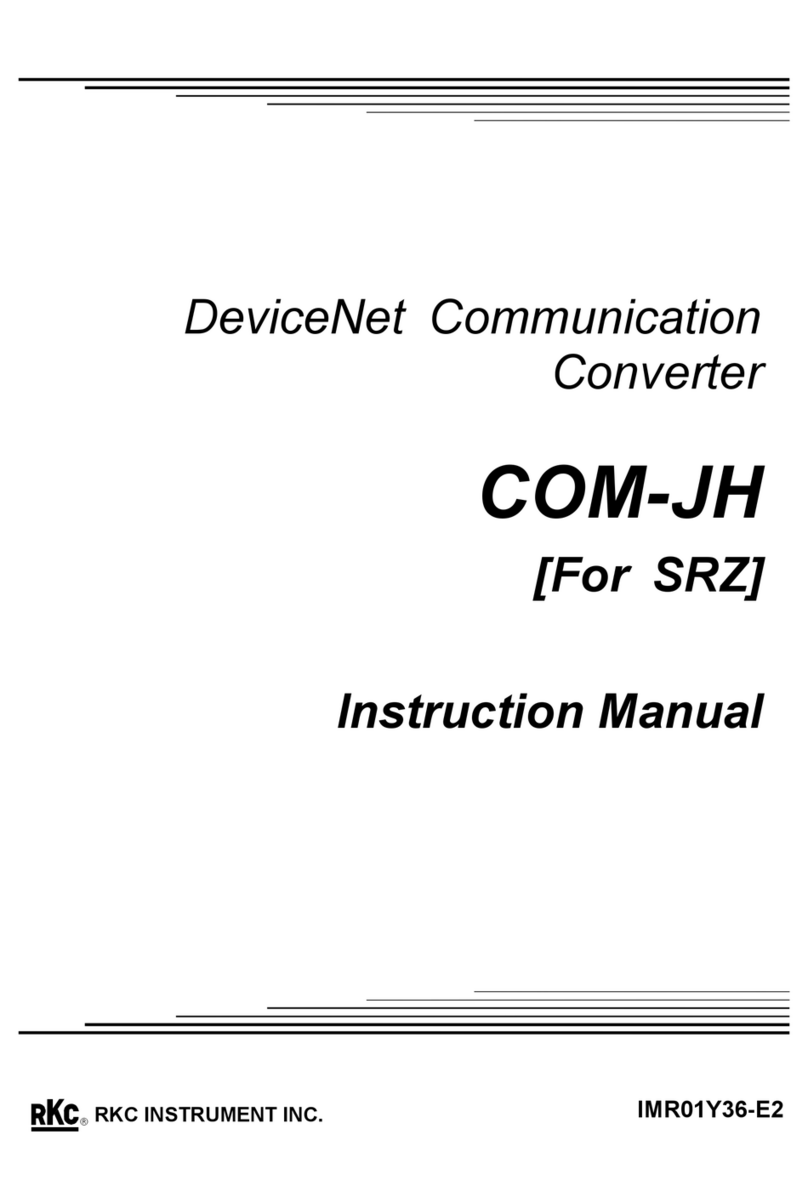
RKC INSTRUMENT
RKC INSTRUMENT COM-JH User manual
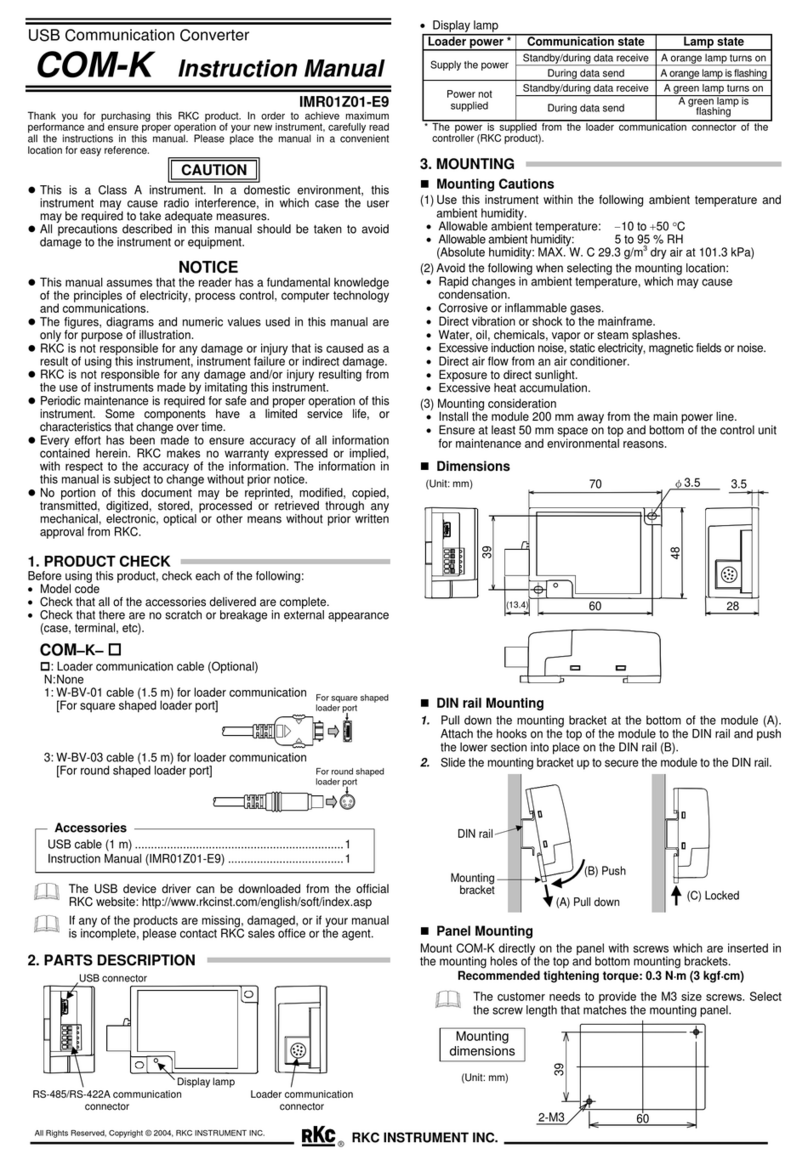
RKC INSTRUMENT
RKC INSTRUMENT COM-K IMR01Z01-E9 User manual
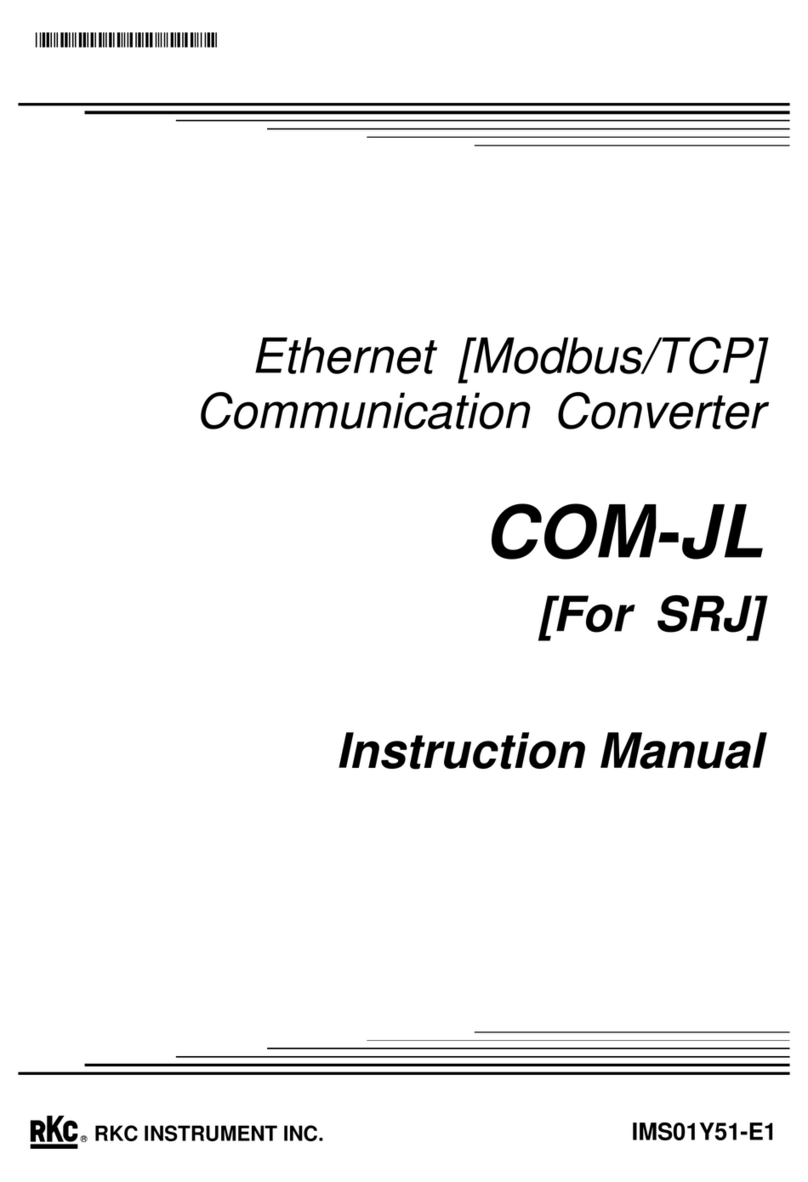
RKC INSTRUMENT
RKC INSTRUMENT COM-JL User manual

RKC INSTRUMENT
RKC INSTRUMENT COM-JL User manual
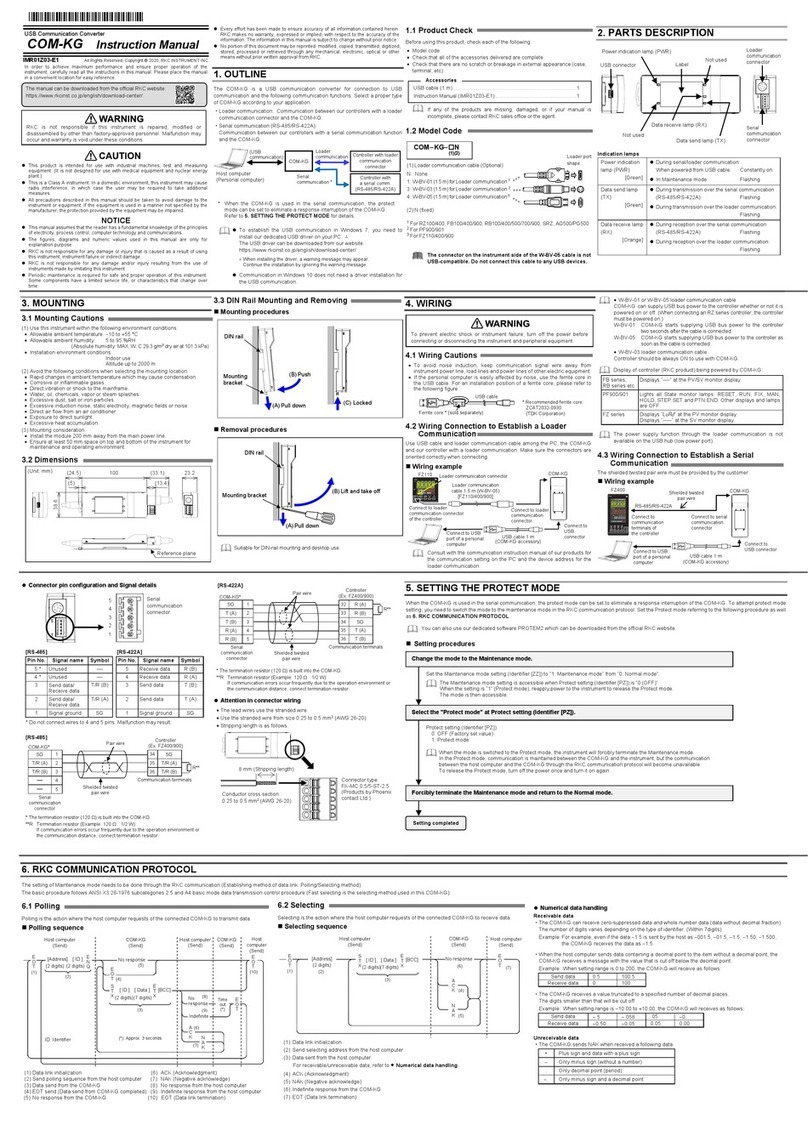
RKC INSTRUMENT
RKC INSTRUMENT COM-KG User manual

